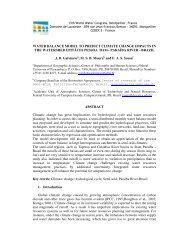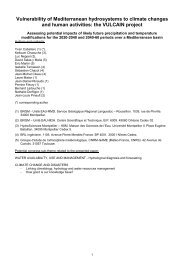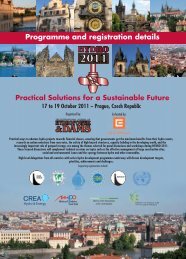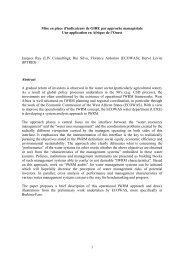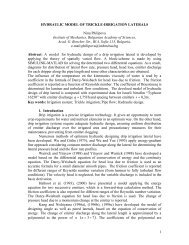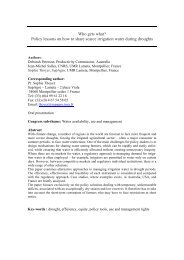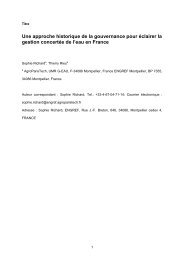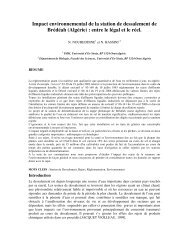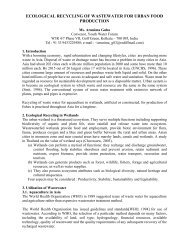Groundwater Use in Earthquake Emergency: A Case Study ... - IWRA
Groundwater Use in Earthquake Emergency: A Case Study ... - IWRA
Groundwater Use in Earthquake Emergency: A Case Study ... - IWRA
Create successful ePaper yourself
Turn your PDF publications into a flip-book with our unique Google optimized e-Paper software.
an example of groundwater use as one of countermeasures for the secure of water <strong>in</strong>the earthquake emergency, which is launch<strong>in</strong>g by Japanese local governments after thehuge Hansh<strong>in</strong>-Awaji (Kobe) earthquake occurred <strong>in</strong> 1995.The Hansh<strong>in</strong>-Awaji Huge <strong>Earthquake</strong>The Hansh<strong>in</strong>-Awaji huge earthquake of M 7.3 was occurred on January 17, 1995,which was the worst natural disaster <strong>in</strong> Japan after the World War II. Around 6,400lives were lost, 40,000 lives were <strong>in</strong>jured and 200,000 households were collapsed. Thishuge earthquake was happened on the Niigata-Kobe stra<strong>in</strong> concentrated belt. On thisstra<strong>in</strong> concentrated belt, many other big earthquakes attacked Japan Island <strong>in</strong> recentlyas shown <strong>in</strong> Fig. 1.In the Hansh<strong>in</strong>-Awaji earthquake, around 1,270,000 households were cut off themunicipal water supply at the immediately after the earthquake and 490,000 households were cut off it even after one week passed. Maximum length of cut off themunicipal water supply was reached 3 months, 90 days after the earthquake <strong>in</strong> somesevere disaster districts. Water use problems <strong>in</strong> the earthquake emergency have beenclosed up <strong>in</strong> Japan as a trigger of this huge earthquake.Direction of crustmovementJapan Sea eastern partstra<strong>in</strong> concentrated beltNiigata-Kobe stra<strong>in</strong>concentrated belt2007: Chuetsu-Oki earthquake (M 6.8)2004: Chuetsu earthquake (M 6.8)2007: Noto Pen<strong>in</strong>sula earthquake (M 6.9)1995: Hansh<strong>in</strong>-Awaji huge earthquake(M 7.3) 6,400 lives were lost,200,000 households were collapsedNagoyaOsakaTokyoFig. 1 Recent occurred big earthquakes <strong>in</strong> Japan (Add to Asahi NP, 2007).Water use problems reported <strong>in</strong> the Hansh<strong>in</strong>-Awaji earthquake are as follows(Research Committee on Secure of Water <strong>in</strong> Huge <strong>Earthquake</strong>, 1999; ProjectCommittee of MLIT, Japan, 2007):・Fire fight<strong>in</strong>g: could not use a hydrant, caus<strong>in</strong>g a big obstruction for fire fight<strong>in</strong>g・Medical activity: transportation of special water with high quality was needed to
hospitals・Dr<strong>in</strong>k<strong>in</strong>g and Cook<strong>in</strong>g: citizens secured sold water for dr<strong>in</strong>k<strong>in</strong>g and cook<strong>in</strong>g・Toilet clean<strong>in</strong>g: huge amounts of water were needed and it was difficult forsecure and transportation itSecure of water for the fire fight<strong>in</strong>g and medical activities is the most urgentlynecessary one <strong>in</strong> the earthquake disaster. In the Hansh<strong>in</strong>-Awaji earthquake, 73.6 % ofhospitals answered to the questionnaire that the ma<strong>in</strong> cause which decl<strong>in</strong>ed the hospitalfunction was cut off the municipal water supply (Yoshioka, 2007).Water Demand Phase, Necessary Amount and Quality <strong>in</strong> <strong>Earthquake</strong> <strong>Emergency</strong>Water demand phase <strong>in</strong> the earthquake disaster may be divided as shown <strong>in</strong> Fig. 2.Phase 1 corresponds to the immediately after to 3 days after the earthquake and itswater demand is concentrated for the fire fight<strong>in</strong>g, the medical activities and thedr<strong>in</strong>k<strong>in</strong>g. In phase 2, water demand for dr<strong>in</strong>k<strong>in</strong>g, cook<strong>in</strong>g, toilet clean<strong>in</strong>g, bath<strong>in</strong>g andwash<strong>in</strong>g and restore the municipal function is necessary. From 4 days after to tillrestore the city area is categorized as phase 3. In this phase, water for expansion of lifewater and restore the construction and the <strong>in</strong>dustry is needed. Figure 3 shows a targetmount of water demand <strong>in</strong> the emergency water supply planed by the Adm<strong>in</strong>istrationOffice of Kobe City, Japan after the huge earthquake. The figure <strong>in</strong>dicates an expectedamount of water demand per person per day depend<strong>in</strong>g on the pass<strong>in</strong>g time after theearthquake. This target amount has been planed based on the concept that restore thePhase 1Phase 3Immediately after ~3 days after 4 days after ~till restore the city areaPhase 2First day ~ord<strong>in</strong>ary restorePhase 1・water for fire fight<strong>in</strong>g・water for medical activity・water for dr<strong>in</strong>k<strong>in</strong>g: 3~18 l/person/dayPhase 3・expansion of life water・water for restore construction・water for restore <strong>in</strong>dustryPhase 2・water for dr<strong>in</strong>k<strong>in</strong>g/cook<strong>in</strong>g/toilet clean<strong>in</strong>g: 40 l/person/day・water for bath<strong>in</strong>g/wash<strong>in</strong>g・water for restore municipal functionFig. 2 Water demand phase <strong>in</strong> earthquake disaster (Research Committee onSecure of Water <strong>in</strong> Huge <strong>Earthquake</strong> Disaster, 1999; Project Committee ofthe MLIT, Japan, 2007).
Table 1 Water needs for each utilization category <strong>in</strong> earthquake disaster(Research Committee on Secure of Water <strong>in</strong> Huge <strong>Earthquake</strong> Disaster,1999; Project Committee of the MLIT, Japan, 2007).Category Time/Place Required amount and qualityFire fight<strong>in</strong>g ・Till around 3 days ・ No need for water quality・ Huge amount・ Constant amountMedical activity ・ Cont<strong>in</strong>uous supply ・ High quality・ Immediately after ・ 5 l /person/day for visitors・ 40~60 l/person/day for<strong>in</strong>patient・ 250 l/person/day for wash<strong>in</strong>gDr<strong>in</strong>k<strong>in</strong>g/cook<strong>in</strong>g ・ Cont<strong>in</strong>uous supply ・ Clean water・ For all place ・ M<strong>in</strong>. 3 l~max. 60 l/person/dayToilet clean<strong>in</strong>g ・ Immediately after ・ No need for water quality unless<strong>in</strong>clud<strong>in</strong>g particles・ Cont<strong>in</strong>uous supply ・ Several 10 l for 2~3 days <strong>in</strong> ave.Bath<strong>in</strong>g/wash<strong>in</strong>g ・Several days~one ・ Clean waterweek after・ 60 l/person/day・ Increase with timeMa<strong>in</strong>tenance of ・ Cont<strong>in</strong>uous supply for ・ Necessary water quality ismunicipal function ma<strong>in</strong> facilities different depend<strong>in</strong>g onutilization purposeRestore water ・ After stable water ・ Necessary water quality issupplydifferent depend<strong>in</strong>g onutilization purpose<strong>in</strong> case for dr<strong>in</strong>k<strong>in</strong>g. This means that the purified water is required for dr<strong>in</strong>k<strong>in</strong>g andcook<strong>in</strong>g, and the management of water quality of groundwater at the ord<strong>in</strong>ary time isnecessary, especially <strong>in</strong> the urban area like Kobe.Figure 5 shows the gett<strong>in</strong>g route of life water such as wash<strong>in</strong>g, bath<strong>in</strong>g and toiletclean<strong>in</strong>g as same <strong>in</strong> Fig. 4. In this case, water quality is not so much required as fordr<strong>in</strong>k<strong>in</strong>g, use of well water <strong>in</strong>creases a little than for the case of dr<strong>in</strong>k<strong>in</strong>g and sourcesfor gett<strong>in</strong>g route are more varieties such as seepage water from the water supply pipe,public water plug on the road and river or sea waters as can be seen <strong>in</strong> Fig. 5.
Effective answer: 76 households <strong>in</strong> KobeOthersBuy<strong>in</strong>g sold waterShared from neighborWell waterWater wagonChose per centFig. 4 Gett<strong>in</strong>g route of dr<strong>in</strong>k<strong>in</strong>g water of Kobe citizens (Research Committeeon Secure of Water <strong>in</strong> Huge <strong>Earthquake</strong> Disaster, 1999).Effective answer: 75 households <strong>in</strong> KobeOthersSeepage water fromwater supply pipeShared from neighborPublic water plugon roadWell waterRiver/sea waterWater wagonChose per centFig. 5 Gett<strong>in</strong>g route of life water of Kobe citizens (Research Committeeon Secure of Water <strong>in</strong> Huge <strong>Earthquake</strong> Disaster, 1999).<strong>Groundwater</strong> <strong>Use</strong> <strong>in</strong> <strong>Earthquake</strong> <strong>Emergency</strong>In case of the Hansh<strong>in</strong>-Awaji earthquake, the recovery of water supply <strong>in</strong> the AwajiIsland was prompt because most of residents have wells at their grounds and couldpumped up shallow groundwater successfully us<strong>in</strong>g hand pump or electricity whichalready recovered with<strong>in</strong> the same day of the earthquake (Yoshioka, 2006).<strong>Groundwater</strong> use <strong>in</strong> the Kobe City was also reported as follows (Kamiya et al,
1998):・17 Jan. (immediately after): used well water for fire fight<strong>in</strong>g by bucket relay with 500citizens・18 Jan. (one day after): 100 m l<strong>in</strong>e was appeared for gett<strong>in</strong>g well water・20 Jan. (3 days after): 200 citizens used groundwater by pump<strong>in</strong>g from 7 m depthwell・24 Jan. (7 days after): “Kikumasamune”, famous Sake (Japanese rice w<strong>in</strong>e) brew<strong>in</strong>gcompany, opened utilization of “Miya-mizu”, brew<strong>in</strong>g groundwater, for citizensfrom 9 AM to 3 PM <strong>in</strong> every day・28 Jan. (11 days after): used well water which was constructed before World War II(around 55 years old one)Table 2 shows water sources for the fire fight<strong>in</strong>g by citizens <strong>in</strong> the Kobe City at theearthquake. It can be seen that compar<strong>in</strong>g with the hydrant, groundwater source is alsoeffectively used for the fire fight<strong>in</strong>g among other water sources.Table 2 Water sources for fire fight<strong>in</strong>g by citizens <strong>in</strong> Kobe City(Research Committee on Secure of Water <strong>in</strong> Huge <strong>Earthquake</strong>Disaster, 1999).Water sourceUtilization numberHydrant 17Well water (GW) 14River water 11Bath stored water 9Tank water of company 5Public bath water 4Pond water 4Table 3 shows the characteristics of water sources for the earthquake disaster. ThisTable may be useful for the risk assessment of water sources <strong>in</strong> the earthquakeemergency. River and sea waters have a large amount <strong>in</strong> quantity but those waters mustbe transported to required places, of which transportation is not easy <strong>in</strong> usual <strong>in</strong> theearthquake emergency. Moreover, sea water should be necessary the treatment for freshwater before the us<strong>in</strong>g. On the other hand, groundwater has an advantage ofco<strong>in</strong>cidence with need and supply places, although the amount of water will beaffected by the earthquake. This advantage of groundwater source will be useful for thedomestic water use such as the <strong>in</strong>itial fire fight<strong>in</strong>g as mentioned above and the toiletclean<strong>in</strong>g which is listed as one of crucial water use problems <strong>in</strong> the earthquakeemergency, especially <strong>in</strong> a Mega City.
Table 3 Characteristics of each water source for earthquake disaster (ResearchCommittee on Secure of Water <strong>in</strong> Huge <strong>Earthquake</strong> Disaster 1999; ProjectCommittee of the MLIT, Japan, 2007)Water source Quantity Quality RemarksRiver, lake ・Large amount ・ Different depend<strong>in</strong>g ・Transportation isand pond waters on source necessarySea water ・Large amount ・Treatment for fresh ・Transportation iswaternecessary<strong>Groundwater</strong> ・Amount will be ・Pollution of shallow ・Co<strong>in</strong>cide with needaffected by GW and supply placesearthquake ・Clean <strong>in</strong> deep GW ・Water table decl<strong>in</strong>e・Water pollution・Set of pump<strong>in</strong>gpowerRa<strong>in</strong> water ・Set of water tank ・Possibly clean, but ・Co<strong>in</strong>cide with need200 l~2,000 m 3 treatment is neces- and supply placessary <strong>in</strong> some timesFor the purpose of dr<strong>in</strong>k<strong>in</strong>g and cook<strong>in</strong>g, quality check of groundwater must benecessary at the ord<strong>in</strong>ary time. Hand pumps or diesel or petrol-driven pumps have tobe prepared for us<strong>in</strong>g groundwater <strong>in</strong> the emergency because the required electricitysupply may not be available after an earthquake.Countermeasures for Secure of Water <strong>in</strong> Disaster <strong>Emergency</strong>After the Hansh<strong>in</strong>-Awaji earthquake, countermeasures for the secure of water <strong>in</strong> thedisaster emergency have been considered by many local governments <strong>in</strong> Japan. One ofsuch countermeasures is the registration system of citizen’s well for disasters. Figure 6shows the panel <strong>in</strong>dicat<strong>in</strong>g the citizen’s cooperation well for disasters <strong>in</strong> the Kobe City.This register system of citizen’s open well has been started from 1996 <strong>in</strong> the Kobe, justone year after the earthquake, and the registered well reached 517 wells by October1998. The list of registered wells and its location map have been prepared by theAdm<strong>in</strong>istration Office of the city and the check of well water quality has been carriedout <strong>in</strong> periodically. Similar registration system has been launched by many other localgovernments, especially <strong>in</strong> a Mega City like Tokyo and Yokohama. For example,Tokyo Metropolitan Government has specified 2,769 wells <strong>in</strong> 23 Wards as for thedisaster well by 1995. In the Yokohama City, the registered well has reached 3,517wells by 1995 and for each well, water quality check has been charged by monthlywith an analytical standard as same as the municipal supply water. The Kokubunji City<strong>in</strong> Tokyo Metropolis has constructed old style well facility constitut<strong>in</strong>g with a hand
Citizen’s cooperation well・Make list and location map・Check of water quality <strong>in</strong>periodically・Registered well: 517 wellsby October 1998・Tokyo MetropolitanGovernment has specified2,769 wells <strong>in</strong> 23 Wards asfor disaster well by 1995For disasterFig. 6 Panel <strong>in</strong>dicat<strong>in</strong>g citizen’s cooperation well for disasters <strong>in</strong> Kobe city(Research Committee on Secure of Water <strong>in</strong> Huge <strong>Earthquake</strong> Disaster, 1999).pump, street furniture and <strong>in</strong>filtration measure system. In total, 8 sets have beenconstructed <strong>in</strong> around the city by 1990 and the ma<strong>in</strong>tenance of the facility has beencharged by the City Adm<strong>in</strong>istration and Citizen’s Prevention Committee.Mapp<strong>in</strong>g of spr<strong>in</strong>gs and wells for us<strong>in</strong>g groundwater <strong>in</strong> disasters emergency hasbeen proceed<strong>in</strong>g not only by the local government but also by citizens. It seems thatlike this map is very useful <strong>in</strong> the disaster emergency at the place where is covered byconcrete jungles due to the urbanization.Utilization of ra<strong>in</strong>water on the roof of households, which is led to the streetfurniture (water tank) with a hand pump is also spread <strong>in</strong> recently <strong>in</strong> Ward districts ofTokyo Metropolis for the purpose of us<strong>in</strong>g stored ra<strong>in</strong>water <strong>in</strong> the emergency as shown<strong>in</strong> Fig. 7. This type of street furniture, which collects ra<strong>in</strong>water for life water us<strong>in</strong>g, hadbeen used <strong>in</strong> Japan already <strong>in</strong> the Edo era, more than 150 years before, as shown <strong>in</strong> Fig.8. This picture shows the ra<strong>in</strong>water pail (bucket) exist<strong>in</strong>g <strong>in</strong> front of the house. It alsocan be seen that the Kanji (Japanese) of “Mizu (water)” is described on the surface ofthe pail. The ra<strong>in</strong>water us<strong>in</strong>g system has been <strong>in</strong>troduc<strong>in</strong>g aga<strong>in</strong> <strong>in</strong> recently as animportant self water source as well as groundwater source <strong>in</strong> the disaster emergency.For the medical activities, to avoid the difficulty of special water transportation <strong>in</strong>the earthquake emergency, some hospitals have <strong>in</strong>troduced a deep well facility as oneof countermeasures, which can supply 80 % of dr<strong>in</strong>k<strong>in</strong>g water at an ord<strong>in</strong>ary time, witha membrane filtration system and a private power plant system. In case of Japan, totalof 353 facilities with like those systems have been <strong>in</strong>troduced by April 2004 <strong>in</strong>clud<strong>in</strong>g116 hospitals (Sugimoto, 2004).
Fig. 7 Street furniture with a hand Fig. 8 Ra<strong>in</strong>water pail (bucket) <strong>in</strong>pump for us<strong>in</strong>g ra<strong>in</strong>water on roof Edo era (Kamiya et al., 1998).<strong>in</strong> Sumida Ward, Tokyo (Kamiyaet al., 1998).Conclud<strong>in</strong>g RemarksThe results <strong>in</strong>dicated that groundwater is very useful water source as the domesticwater for toilet clean<strong>in</strong>g, which is one of big water use problems and needs a hugeamount of water <strong>in</strong> the earthquake emergency. <strong>Groundwater</strong> is also useful water sourcethan river or pond waters for the fire fight<strong>in</strong>g as demonstrated <strong>in</strong> the case ofHansh<strong>in</strong>-Awaji earthquake. For the purpose of dr<strong>in</strong>k<strong>in</strong>g and cook<strong>in</strong>g, quality check ofgroundwater must be necessary at the ord<strong>in</strong>ary time. Hand pumps or diesel orpetrol-driven pumps have to be prepared for us<strong>in</strong>g groundwater <strong>in</strong> the emergencybecause the required electricity supply may not be available after the earthquake.It makes clear that the registration system of citizen’s well is launch<strong>in</strong>g by manyJapanese local governments and mapp<strong>in</strong>g of spr<strong>in</strong>gs and wells is also proceed<strong>in</strong>g bylocal government or by citizens for us<strong>in</strong>g groundwater <strong>in</strong> emergency purposes. Somehospitals have <strong>in</strong>troduced a deep well facility with a membrane filtration system and aprivate power plant system. Moreover, <strong>in</strong> recently, utilization of ra<strong>in</strong>water on the roofof households, which is led to a street furniture (water tank) with hand pump, is alsospread <strong>in</strong> the Tokyo Metropolis for the purpose <strong>in</strong> emergency use.<strong>Groundwater</strong> is a significant water source <strong>in</strong> an earthquake emergency. For thispurpose, establishment of a cont<strong>in</strong>uous monitor<strong>in</strong>g system of groundwater <strong>in</strong>clud<strong>in</strong>g itswater quality is an urgently necessary matter, especially <strong>in</strong> the tectonic region <strong>in</strong> theworld.
ReferencesAsahi NP (2007): Morn<strong>in</strong>g News Paper on 26 July, 2007.Kamiya, H. et al. (1998): Well and Water Route. Hokuto Shuppan, 202p. (<strong>in</strong> Japanese)Kawahara, K. (2004): Practice of four dimensional water cycle. http://www.higash<strong>in</strong>ihon.ne.jp/news/pdf/, 11p. (<strong>in</strong> Japanese)Project Committee of the M<strong>in</strong>istry of Land, Infrastructure and Transport (MLIT),Japan (2007): Future-Oriented <strong>Groundwater</strong> Resource Management. 81p. (<strong>in</strong>Japanese)Research Committee on Secure of Water <strong>in</strong> Huge <strong>Earthquake</strong> Disaster (1999): OnSecure of Water <strong>in</strong> Huge <strong>Earthquake</strong> Disaster <strong>in</strong> a Mega City. 106p. (<strong>in</strong> Japanese)Sugimoto, J. (2004): Increas<strong>in</strong>g the groundwater use <strong>in</strong> hospitals. New MedicalTreatment. (<strong>in</strong> Japanese)Yoshioka, R. (2006): The earthquakes recently occurred <strong>in</strong> <strong>in</strong>land regions of Japan andlifel<strong>in</strong>es focus<strong>in</strong>g on groundwater. Presented Paper at the WG Meet<strong>in</strong>g on GWES,UNESCO IHP-VI, Paris, 8p.Yoshioka, R. (2007): Impact of Hyogo-Nanbu earthquake on groundwater use <strong>in</strong>emergency. Presented Paper at the WG Meet<strong>in</strong>g on GWES, UNESCO IHP-VI,Tsukuba, Japan, 3p.



